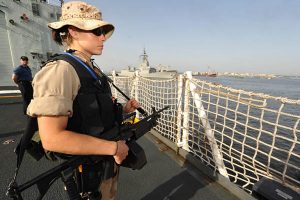Women in the war zone
By Lookout on Jul 03, 2012 with Comments 0

Counter-piracy. On April 26, 2009 a member of the Naval Boarding Party stands watch as Her Majesty’s Canadian Ship (HMCS) Winnipeg participates in an SNMG1 port visit to Karachi Pakistan to increase awareness of NATO activities in the region.
Royal Roads University, the Asia Pacific Center for Security Studies, and Maritime Forces Pacific will be holding the biennial Maritime Security Challenges conference in Victoria, B.C. from Oct 1-3, 2012
Women have made tremendous strides in the United States Armed Forces; however, many still seek further equality in the realm of combat operations.
In February, the Pentagon opened up 14,000 positions for servicewomen that were previously unavailable to them, marking a milestone that will see females in roles such as intelligence officers, tank mechanics, and rocket launcher crew members.
While there are still approximately 255,000 combat-related roles that women are prohibited from participating in, the nature of modern warfare has distorted the concept of front lines, ensuring that every person deployed to a warzone, male or female, has the potential to become involved in combat.
The unbalanced differentiation between the U.S. military and the adversaries they face in combat zones in Afghanistan and Iraq have forced insurgent groups to confront American and allied forces in irregular ways, which have made non-combat roles extremely dangerous. The threat of suicide bombings, improvised explosive devices, and ambush tactics carried out by guerrillas disguised as allied security forces have all been evident in countless instances. This challenge of unconventional warfare has increased the demand for more combat-ready troops, and has led the U.S. military to allow women to be attached to battle units.
Although women cannot officially participate in U.S. infantry or special forces operations, they are still regularly subject to warfare dangers through attachment to combat groups in supporting roles such as translators. Attachments are temporary postings of soldiers from one unit to another in order to provide specialized assistance to the new group, but differ from assignments, which are permanent positions within a unit. The duties performed by an attached soldier are virtually the same as those for an assigned serviceperson, but despite the de facto role they can play in battle, women are still not officially recognized as equals.
Approximately 14 percent of U.S. forces are female and despite being nominally disconnected from combat duties, 144 female American troops have been killed and more than 850 have been wounded in wars in Central Asia and the Middle East since 2001.
Regardless of the importance of women in the U.S. military, there remains opposition to female roles in war fighting. Some argue that women do not have the same physical strength as men and that testing standards would have to be lowered to make up for this. Others think that combat effectiveness would diminish because the psyche of a warzone could change with the inclusion of women. However, despite this contention, there are women who do meet current physical requirements. And effectiveness and professionalism in a warzone depends on the character of the individual, not the gender. These issues are currently being pursued by equal opportunity supporters, though there are legal ramifications to consider.
Approximately one week after the Pentagon’s implementation of its new policy for women, two female U.S. Army reservists filed a lawsuit against Defence Secretary Leon Panetta and Army Secretary John McHugh claiming that the restriction on official female participation in warfare limits women’s career and earning potential and violates their constitutional rights. Service in the infantry is essential to career advancement in the U.S. military, leading some gender equality advocates to conclude that combat-exclusionist policies hold most women back from progressing through the ranks.
While some say that the recent Pentagon policy changes do not go far enough towards gender equality compared to other western nations, adherents maintain that the move is a significant advancement.
Currently, 13 other countries, including Canada and Australia, allow women to participate in official combat roles. This inclusion has broadened the pool of recruits available for active duty, allowed commanders to choose the most competent people for the job regardless of gender, and worked to counter sexism by enabling women to attain the highest-ranking positions.
U.S. servicewomen are already fighting and dying on foreign battlefields. However, in order for the U.S. Armed Forces to gain the diversity and resource pool they need to continue fighting these wars, women need to be officially recognized for their contributions. While recent Pentagon policy changes are a positive step forward, the lawsuit filed against Department of Defense staff ensures that the fight for equality is not over.
The Office of the Asia Pacific Advisor provides unclassified daily news summaries on security events around the world. Email Daniel.Baart@forces.gc.ca to sign up.
Craig Graham, Office of the Asia-Pacific Advisor
Filed Under: Top Stories
About the Author:





